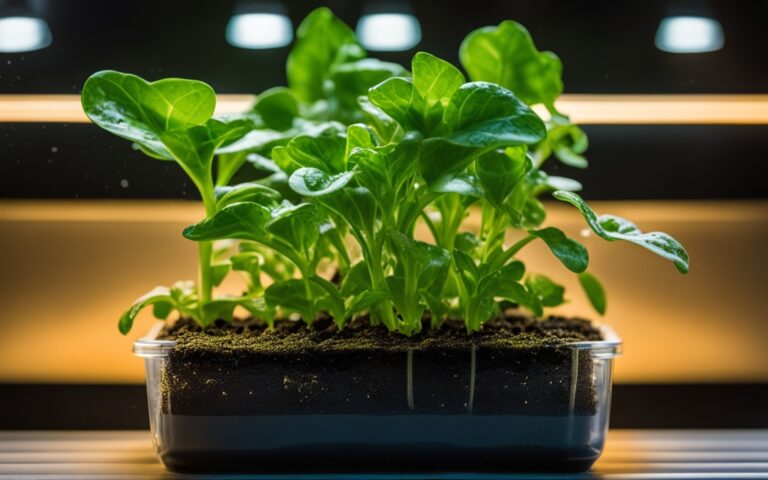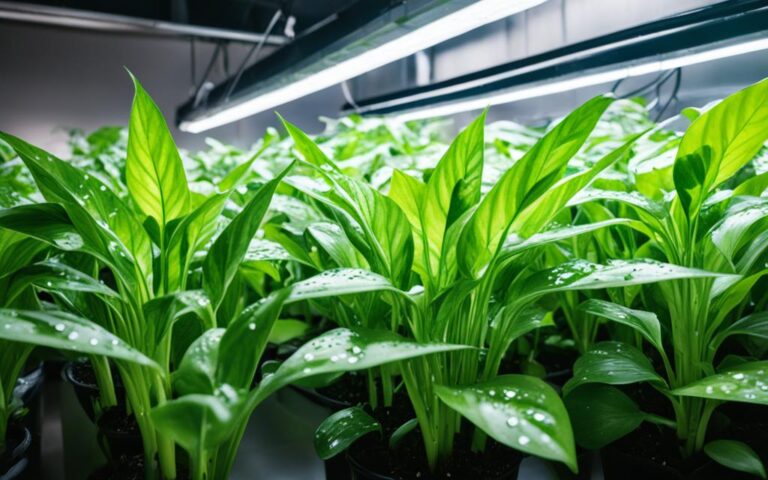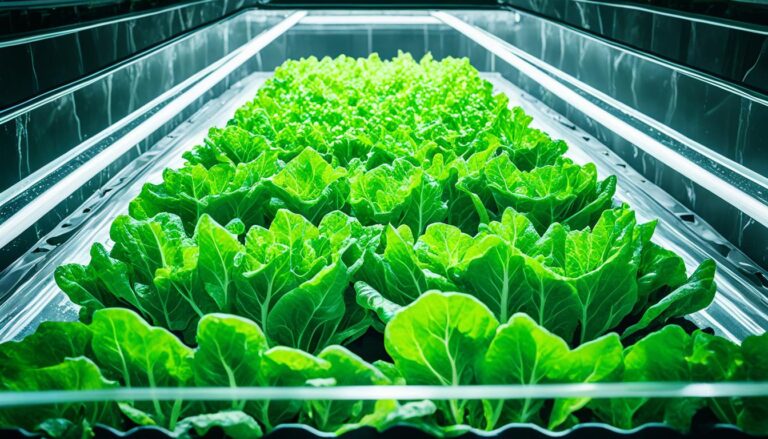Growing Hydroponic Watermelon: Tips and Techniques
Hydroponic farming is a modern way to grow plants without soil. It uses a water solution full of nutrients for plant growth. Watermelon can be grown hydroponically, surprising many people. This method is popular because it grows plants faster, produces more, and needs less space. We’ll share tips on growing hydroponic watermelons, from picking the best varieties to getting the most out of your space.
Key Takeaways
- Watermelons can be grown in hydroponic systems like NFT, ebb and flow, and drip irrigation.
- Hydroponic watermelon farming gives better yields, plant health, and fewer pests than traditional farming.
- Getting nutrients right, controlling temperature, and supporting plants are key for growing hydroponic watermelons.
- Hydroponic watermelons fit well in small spaces, making them great for indoor and greenhouse farming.
- Keeping an eye on your plants and fixing any issues is vital for their health and success.
Table of Contents
Introduction to Hydroponic Watermelon Cultivation
Hydroponic watermelon farming is a great way for growers to get more from their land and save water. It uses a soilless setup to give plants the nutrients they need fast. This leads to quicker growth, more fruit, and watermelon available all year. It’s also better for the planet.
Benefits of Growing Watermelons Hydroponically
Hydroponic watermelon farming has many perks. It beats traditional farming in several ways:
- Faster growth and maturation of watermelon plants, leading to quicker harvests and the potential for multiple growing cycles per year.
- Higher yields due to the precise control over nutrient delivery and the elimination of soil-borne pests and diseases.
- Efficient water usage, as hydroponic systems recirculate and reuse the nutrient solution, reducing water consumption by up to 90%.
- Year-round production capabilities, enabling growers to provide fresh, locally-sourced watermelons even during the off-season.
- Reduced reliance on pesticides, as the controlled environment of a hydroponic system minimizes the need for chemical interventions.
Overview of the Hydroponic Watermelon Growth Process
The process of growing hydroponic watermelons includes several key steps. First, picking the right varieties is crucial. Then, keeping the right levels of nutrients, light, and temperature is important. Growers also need to train the plants, pollinate them, and watch out for pests and diseases.
“Hydroponic watermelon cultivation is a game-changer, allowing growers to produce abundant, flavorful watermelons while using a fraction of the water and land required by traditional methods.”
As more people want watermelons, hydroponic farming is becoming a key solution. It lets farmers grow more watermelons with less water and land. This approach supports sustainable farming, making more food available while protecting the environment.
Selecting the Right Watermelon Varieties for Hydroponics
Choosing the right watermelon varieties is key for hydroponic success. Smaller watermelons fit well in hydroponic systems because they need less space and grow fast. ‘Sugar Baby’, ‘Golden Midget’, and ‘Garden Baby’ are great choices, growing to 6 to 10 pounds.
Larger varieties like ‘Charleston Gray’, ‘Crimson Sweet’, and ‘Jubilee’ can reach 40 pounds. But, they take up more space and need more care. When picking hydroponic watermelon varieties, think about how long they take to mature, their nutrient needs, and how they handle pests and diseases.
| Variety | Size | Maturity Time | Suitability for Hydroponics |
|---|---|---|---|
| Sugar Baby | 6-10 lbs | 70-80 days | Excellent |
| Golden Midget | 6-8 lbs | 65-75 days | Excellent |
| Garden Baby | 8-10 lbs | 75-85 days | Excellent |
| Charleston Gray | 20-40 lbs | 85-95 days | Good |
| Crimson Sweet | 20-30 lbs | 80-90 days | Good |
| Jubilee | 30-40 lbs | 90-100 days | Fair |
Choosing the right hydroponic watermelon varieties helps growers get a great harvest. They ensure their hydroponic systems work well and produce tasty, healthy watermelons.

“The key to successful hydroponic watermelon cultivation is selecting the right variety that thrives in a compact, controlled environment.”
Setting Up Your Hydroponic System for Watermelon
Getting your hydroponic system ready for watermelon needs careful planning. A good setup gives enough room for the vines and makes sure the roots get the right nutrients and oxygen. This is key for growing juicy watermelons.
Types of Hydroponic Systems Suitable for Watermelons
Many hydroponic systems work well for watermelons. The deep-water culture (DWC) system is great because watermelons need lots of water and nutrients. The ebb-and-flow system, which changes between flooding and draining, is also good for hydroponic watermelon growing.
Essential Components and Equipment Needed
It doesn’t matter which system you pick, you’ll need things like grow trays, air pumps, grow lights, and strong trellises. These help create the best environment for hydroponic watermelons. Some important items and things to think about include:
- Grow trays or containers big enough for the vines
- Strong air pumps for good root oxygen
- Adjustable grow lights for 8-10 hours of light a day
- Sturdy trellises to keep the heavy fruits from damaging the vines
- Systems to check and control pH, temperature, and nutrients
With the right hydroponic system and these key items, you’re set to grow a lot of hydroponic watermelon.
Preparing the Growing Medium and Nutrient Solution
In a hydroponic system, the growing medium and nutrient solution are key to growing watermelons. Perlite, clay pellets, or pea gravel are great for the growing medium. They support the vines well and don’t hold too much moisture, ensuring good air flow for the roots.
The nutrient solution must be balanced for watermelon plants. A complete hydroponic fertilizer with lots of potassium and phosphorus helps with growth, fruit size, and fighting diseases. It’s important to keep the pH level (5.8-6.2) and electrical conductivity (EC of 1.2-1.5) right for the plants to absorb nutrients well.
Growing Media Options for Hydroponic Watermelons
- Perlite: A lightweight, porous material that provides excellent aeration and drainage for watermelon roots.
- Clay Pellets: Offer sturdy support and efficient water and nutrient delivery to the plants.
- Pea Gravel: A coarse, inert medium that promotes strong root development and air circulation.
These growing media are perfect for hydroponic watermelons. They balance moisture, nutrients, and oxygen for the best growth and health.
“Hydroponic gardens use 90% less water than traditional agriculture, highlighting significant water conservation.”
Planting and Germination Techniques
Starting your hydroponic watermelon journey can be done in two ways: by sowing seeds or using pre-started transplants. Let’s look at each method closely.
Sowing Hydroponic Watermelon Seeds
For starting from seed, use a clean, soilless mix like rockwool cubes or coco coir. Keep the temperature between 80-90°F (27-32°C) to help seeds germinate well. Make sure the seedlings get enough light, either from the sun or artificial sources, as they grow their first leaves.
Once the seedlings have their first leaves, start feeding them a weak hydroponic nutrient mix. This will help them grow strong.
Using Hydroponic Watermelon Transplants
Or, you can buy pre-started watermelon transplants to speed up the process. Make sure to slowly adjust them to the hydroponic setup to prevent shock. Plant them 2-3 feet apart in rows that are 6-8 feet apart.
Whether you begin with seeds or transplants, creating the right environment is key for your hydroponic watermelon plants. By following these steps, you’ll set the stage for a successful harvest.
| Metric | Value |
|---|---|
| pH range for ideal soil conditions | 6.5–7.5 |
| Temperature range for germination | 80–90°F (27–32°C) |
| Spacing for transplanting | 2–3′ apart in rows 6–8′ apart |
| Temperature for growing seedlings | 75°F (24°C) |
| Recommended spacing for direct seeding | 3 seeds every 18–36″ |
| Approximate seeds per pound | 9,700 |
Optimizing Light and Temperature Requirements
Hydroponic watermelon farming needs careful attention to light and temperature for best growth and lots of fruit. Watermelons love lots of sunlight, needing 8 to 10 hours a day. If you’re growing them in a greenhouse or indoors, hydroponic watermelon grow lights can help make up for the lack of sunlight.
The perfect temperature for hydroponic watermelon is between 70-85°F (21-29°C) during the day and above 60°F (15°C at night. This temperature is key because watermelons don’t like too much heat or cold. In places like greenhouses or indoor setups, you might need to use extra heating or cooling to keep the plants just right.
Ideal Light Conditions for Hydroponic Watermelons
For top results in watermelon greenhouse production, you should have at least 6,000-8,000 lux (600-800 μmol/m²/s) of light for 8 hours a day. LED or high-pressure sodium lamps work well to give the plants the full spectrum of light they need for photosynthesis and growth.
Temperature Range for Maximum Growth
Watermelons do best in warm, well-drained soil. The soil should be around 70-75°F (21-24°C) for seed germination. During the day, the air should be between 75-85°F (24-29°C). At night, it should stay above 60°F (15°C) to keep the plants growing well and stress-free.
By managing the hydroponic watermelon light requirements and temperature, you can make sure your plants grow well. This leads to lots of juicy, tasty watermelons.

Nutrient Management and Fertilizer Preparation
Getting the right nutrient management is key to growing top-notch, tasty hydroponic watermelons. Watermelons need a lot of nutrients, especially potassium and phosphorus. Potassium boosts fruit quality and fights diseases. Phosphorus helps roots grow and flowers bloom. Nitrogen is important early on for healthy leaves.
When making the nutrient solution, aim for an electrical conductivity (EC) of 1.2-1.5 and a pH of 5.8-6.4. Keep an eye on the nutrient levels and pH often. This ensures your watermelon plants get what they need to grow well and produce lots of fruit.
Essential Nutrients for Hydroponic Watermelon Plants
The main hydroponic watermelon nutrients are:
- Potassium (K): Helps make better fruit, fight diseases, and keeps plants strong.
- Phosphorus (P): Helps roots grow, flowers bloom, and fruit form.
- Nitrogen (N): Makes leaves grow big, especially when plants are young.
- Calcium (Ca): Important for cell walls and fruit quality.
- Magnesium (Mg): Helps make chlorophyll and enzymes work right.
- Micronutrients: Iron, boron, copper, zinc, and manganese, needed in small amounts.
The hydroponic fertilizer for watermelon should mix these important nutrients well. This supports strong growth and fruiting.
“Watermelons are being grown in Florida, Holland, and the United States using 100% perlite substrate in bags or containers, which can be recycled after proper cleaning and disinfecting.”
The best fertilizer for hydroponic watermelon has more potassium and phosphorus than nitrogen. The right mix changes with the plant’s growth stage. It’s important to watch and adjust the nutrients to get the best yield and quality from your hydroponic watermelons.
hydroponic Watermelon Plant Training and Support
Growing hydroponic watermelons needs careful attention to their growth and support. The vines can get big and spread out. So, it’s key to use hydroponic watermelon trellising or hydroponic watermelon vine support. This helps them grow well and produce lots of tasty fruit.
Trellising and Supporting Vines for Optimal Growth
Supporting the vines as they grow is crucial for hydroponic watermelons. You can use tomato cages, wire mesh, or wooden trellises to keep them up high. This stops the fruit from touching the ground and getting damaged.
Attach the vines to the support gently with soft ties or clips. Make sure they can still move freely. This vertical gardening method saves space and keeps pests away. It also lets the watermelons get lots of sunlight, helping them grow strong.
| Benefits of Hydroponic Watermelon Trellising | Challenges of Unsupported Watermelon Vines |
|---|---|
| Keeps vines off the ground, preventing rot and damage to fruit Improves air circulation and sunlight exposure Conserves valuable growing space in a hydroponic system Promotes overall plant health and productivity | Reduced air flow and sunlight exposure can hinder plant growth Sprawling vines take up excessive space in a hydroponic setup Increased risk of pest and disease problems |
Using good hydroponic watermelon plant training and support helps growers get the most from their plants. This way, they can enjoy a big and healthy harvest.

Monitoring Plant Health and Troubleshooting
Keeping your hydroponic watermelon plants healthy is key to a great harvest. Check on your plants often and fix problems quickly to help them grow well.
Common Pests and Diseases in Hydroponic Watermelons
Hydroponic watermelon plants face pests like spider mites, aphids, thrips, and whiteflies. These pests can harm your plants, causing them to grow poorly, turn color wrong, and produce less. Use yellow sticky traps and check your plants for pests often to control them.
Hydroponic watermelon diseases like powdery and downy mildew can also hit your plants. These diseases can make plants look bad, grow slowly, and even die if not treated. Keep air moving well, lower humidity, and pick disease-resistant plants to fight these diseases.
Identifying and Addressing Nutrient Deficiencies
Getting the right nutrients is key for your hydroponic watermelon plants. Hydroponic watermelon nutrient deficiencies can show as plants look bad, grow slow, or don’t make good fruit. Watch for these signs and adjust the nutrients as needed to fix problems.
| Nutrient Deficiency | Symptoms | Corrective Action |
|---|---|---|
| Nitrogen | Yellowing of older leaves, stunted growth | Increase nitrogen in the nutrient solution |
| Phosphorus | Dark green or purple leaves, slowed growth | Increase phosphorus in the nutrient solution |
| Potassium | Leaf margins turning brown or scorched | Increase potassium in the nutrient solution |
| Calcium | Distorted new growth, tip burn on leaves | Increase calcium in the nutrient solution |
Watch your hydroponic watermelon plants closely and fix any problems quickly. This way, you can have a healthy and big harvest. Be alert and adjust your system as needed to keep your plants doing well.
Pollination Techniques for Hydroponic Watermelon
Proper pollination is key to growing hydroponic watermelons successfully. Hydroponic systems often don’t have the natural pollinators soil gardens do. So, growers must help pollinate by hand. Hydroponic watermelon pollination is vital for big, juicy fruits.
For hand pollination for hydroponic watermelon, gently shake the flowers or use a soft-bristle brush to move pollen. This ensures the flowers get the pollen they need to make watermelons.
It’s also important to keep the humidity right, between 60-70%. This helps flowers stay fertile and sets fruit well. The right environment helps with pollination and makes more watermelons.
- Gently shake the plant’s flowers or use a soft-bristle paintbrush to transfer pollen from male to female flowers.
- Maintain humidity levels between 60-70% to support flower fertility and fruit set.
- Monitor and assist the pollination process as needed to ensure successful watermelon development.
| Pollination Method | Ideal Humidity Range | Outcome |
|---|---|---|
| Hand pollination using a brush or shaking | 60-70% | Successful fruit development and large, juicy watermelons |
“Proper pollination is the key to unlocking the full potential of hydroponic watermelon cultivation. By taking a hands-on approach and creating the right growing environment, growers can maximize their yields and enjoy the sweet rewards of their efforts.”
Harvesting and Storage Tips
Knowing when to pick your hydroponic watermelons is key to enjoying their best taste and juiciness. Look for signs like the flower falling off, a webbing on the rind, and a sweet smell. Also, ripe watermelons come off the vine easily without needing much force.
After picking, hydroponic watermelons can stay fresh in the fridge for a long time. Curing and handling them right will make your harvest last longer and taste better.
Signs of Ripeness in Hydroponic Watermelons
- The original flower on the fruit has fallen off.
- A distinct webbing or netting has developed on the rind.
- The fruit emits a sweet, melon-like aroma.
- The watermelon separates from the vine with a gentle tug.
Watch for these signs to pick your hydroponic watermelons at the best time. This way, you get the most flavor and freshness from your homegrown watermelons.
| Watermelon Characteristic | Ideal Range |
|---|---|
| Soil pH | 6.0 – 6.8 |
| Water Requirements | 1-2 inches per week |
| Germination Temperature | 70-80°F |
| Germination Time | 7-10 days |
| Harvest Timing | 1 week of decreased watering |
| Refrigerator Storage Time | Up to 1 week |
Follow these tips for when to harvest hydroponic watermelon and hydroponic watermelon ripeness. Also, use the right storage techniques. This way, your homegrown watermelons will always be at their best.
Maximizing Yields and Extending the Growing Season
Hydroponic watermelon farming lets you grow more and for longer. Use a water culture system with a small heater to keep roots warm in cool weather. This way, you can start or keep growing your crop longer. Also, hydroponics lets you fit more plants in a small area than traditional gardens.
Good nutrient care, pest control, and training help increase hydroponic watermelon yields. With the right methods, you can have fresh watermelons almost all year.
Increasing Hydroponic Watermelon Yields
To get more hydroponic watermelons, try these tips:
- Keep the roots warm with a small heater to grow longer
- Use vertical farming and compact setups to grow more in less space
- Adjust the fertilizer to what the plant needs at each stage
- Keep pests away to keep plants healthy
- Train vines to get more flowers and bigger fruits
Extending the Hydroponic Watermelon Growing Season
To grow watermelons longer, use vertical farming and water-based systems:
- Start your crop early with a system that controls root temperature
- Grow watermelons all year with the right temperature, humidity, and light indoors
- Use LED lights for efficient lighting to help with natural light
- Try vertical farming to make the most of limited space
With these methods, you can grow hydroponic watermelons longer and have a steady supply all year.
Conclusion
Growing watermelons hydroponically has many benefits of hydroponic watermelon over traditional farming. It uses a nutrient-rich water solution and a controlled environment. This leads to faster growth, more fruit, and watermelon all year round. The hydroponic watermelon advantages include needing less space, using water more efficiently, and controlling the plants’ conditions.
Choosing the right variety, managing nutrients, and using the right support systems are key. You can enjoy the sweet taste of hydroponic watermelon vs. soil-grown in your backyard or indoor garden. It’s great for both experts and beginners. Adding watermelons to your hydroponic setup is rewarding and tasty.
Hydroponic farming lets you fully enjoy watermelon production. You get to taste the refreshing, nutrient-rich watermelons all year.






